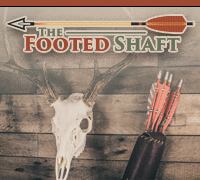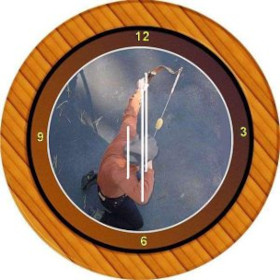Hi Lowell,
I haven't done that exact testing but the results are fairly easy to calculate given enough background data.
First of all, you need to know SE/PDF28 and SE/PDF30 for the bow in question. Let's say that SE/PDF 28 is 0.900 and SE/PDF30 is 1.000. That means that the 55# @ 30" bow stores 55 ft-lbs of energy.
Second, we need to know what the DE (dynamic efficiency) of the bow design being tested is. My testing results suggest that there's very little (so small it's hard to measure) difference in DE at varying draw lengths (within reason GIVEN CONSTANT GRAINS PER POUND ARROW WEIGHT).
But, given that DE varies with grains per pound, let's assume in this example that the 55# @ 30" bow is shooting a 10 gpp arrow, or 550 grains. Further, let's assume that in this example we want to know what draw weight in the same design bow is needed to shoot THE SAME 550-GRAIN ARROW THE SAME SPEED.
Now we calculate: the 55# @ 30" bow stores 55 ft-lbs of energy and the arrow shot from that bow (because of the DE of 85% - a very high number FWIW) contains 55 ft-lbs*0.85=46.75 ft-lbs of energy. Knowing the equation for kinetic energy, we can calculate the speed of the arrow being shot from this particular 55# @ 30" bow. An arrow weighing 550 grains (10 gpp) with 46.75 ft-lbs of energy is traveling at 195.6 fps.
To quote from one of my college differential equations books "therefore it should be obvious to the most casual observer that....." the same bow design being drawn to 28" and shooting the same 550-grain arrow the same speed will also have to deliver 46.75 ft-lbs of energy to the arrow. The DE for the 28" example will be lower because in order to shoot the same arrow the same speed (and therefore have the same total ft-lbs of energy), the bow being drawn to 28" will have to have a higher draw weight at 28" than 55#. Iteration here is necessary to fine-tune the answer but I'll cut to the chase with a simplifying assumption: With the higher draw weight at 28" let's assume DE drops from .85 to .835 when shooting the same 550 grain arrow at the same speed of 195.6 fps.
Now the solution is easy and simple. The same bow design being drawn to 28" delivers 46.75 ft-lbs to the arrow. Its DE is .835, so that means it must store 46.75/.835=56 ft-lbs of energy. And given the fact that SE/PDF28 = 0.900 the bow being drawn to 28" must have a draw weight of 56/.900=62.2#.
The answer from this example based on reasonable numbers for a better-than-average recurve is: Bow of "X" design and manufacture being drawn to 55# @ 30" would have to be 62.2# @ 28" in order to shoot the same 550-grain arrow the same speed.
Now, if we wanted to keep the gpp constant the DE for the 28" bow would be higher, and through iteration we could hone in on the answer. Suffice to say that somewhere in the 60-62# range at 28" would shoot the same arrow the same speed as a bow of precisely the same design being drawn to 55# @ 30".
There are several more examples in our website that provide more background and explanation if you're interested:
http://www.dryadbows.com/Defining%20Bow%20Performance%20Dryad.pdf













